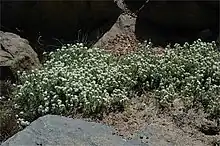Pimelea humilis
Pimelea humilis, also known as common riceflower[2] or dwarf riceflower,[3] is a species of flowering plant in the family Thymelaeaceae and is endemic to south-eastern Australia. It is an erect or scrambling shrub with hairy stems, elliptic to lance-shaped leaves and heads of 12 to 52 of creamy-white, bisexual or female flowers.
| Common riceflower | |
|---|---|
 | |
| Scientific classification | |
| Kingdom: | Plantae |
| Clade: | Tracheophytes |
| Clade: | Angiosperms |
| Clade: | Eudicots |
| Clade: | Rosids |
| Order: | Malvales |
| Family: | Thymelaeaceae |
| Genus: | Pimelea |
| Species: | P. humilis |
| Binomial name | |
| Pimelea humilis | |
| Synonyms[1] | |

Description
Pimelea humilis is an erect or scrambling that typically grows to a height of 5–50 cm (2.0–19.7 in) and has densely hairy young stems. Its leaves are arranged in opposite pairs, narrowly elliptic to lance-shaped, mostly 5–16 mm (0.20–0.63 in) long, 1–9 mm (0.039–0.354 in) wide on a short petiole. The flowers are arranged in clusters of 12 to 52 on a peduncle 2–19 mm (0.079–0.748 in) long, surrounded by 4 or 6 egg-shaped involucral bracts 6–18 mm (0.24–0.71 in) long, 3–11 mm (0.12–0.43 in) wide and green with a yellow base. The flowers are creamy-white, the flower tube 8–15 mm (0.31–0.59 in) long, the sepals 1–5 mm (0.039–0.197 in) long, and the stamens shorter than the sepals. Flowering occurs from September to December and the fruit is green and about 4 mm (0.16 in) long.[2][3][4][5]
Common riceflower is similar to P. linifolia but is smaller, softer and has hairy stems.[6]
Taxonomy
Pimelea humilis was first formally described by Robert Brown in Prodromus Florae Novae Hollandiae in 1810.[7][8] The specific epithet (humilis) means "low" or "low-growing".[9]
Distribution and habitat
Common riceflower grows in heath, woodland, forest and grassland, often in sandy soil. It is widespread and common in Victoria, but less common in New South Wales, growing at Robertson and south of Eden. It also occurs east of the Mount Lofty Range in South Australia and in north-eastern Tasmania.[2][3][4][5]
References
- "Pimelea humilis". Australian Plant Census. Retrieved 7 January 2023.
- "Pimelea humilis". State Herbarium of South Australia. Retrieved 7 January 2023.
- Harden, Gwen J. "Pimelea humilis". Royal Botanic Garden Sydney. Retrieved 7 January 2023.
- Rye, Barbara L. "Pimelea humilis". Flora of Australia. Australian Biological Resources Study, Department of Agriculture, Water and the Environment: Canberra. Retrieved 7 January 2023.
- Entwisle, Timothy J. "Pimelea humilis". Royal Botanic Gardens Victoria. Retrieved 7 January 2023.
- Jordan, Greg. "Pimelea humilis". University of Tasmania. Retrieved 7 January 2023.
- "Pimelea humilis". APNI. Retrieved 7 January 2021.
- Brown, Robert (1810). Prodromus florae Novae Hollandiae et insulae Van-Diemen, exhibens characteres plantarum quas annis 1802-1805. London. p. 361. Retrieved 7 January 2023.
- William T. Stearn (1992). Botanical Latin. History, grammar, syntax, terminology and vocabulary (4th ed.). Portland, Oregon: Timber Press. p. 427.